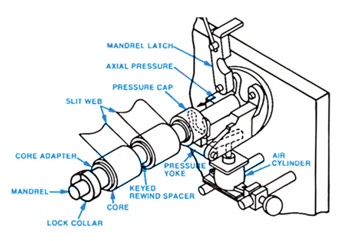
There is often some confusion as to what type of rewinding method is appropriate for certain slitter rewinder applications. To shed some light on the topic, we’ve put together a quick overview on the differential versus locked-core method below.
Differential rewinding: In slitter rewinders, the most common type of center winding is the duplex type slitter rewinder. This is an application of center winding that very often utilizes a differential rewinding technique. A large majority of the materials that are converted have minute variations in thickness (gauge) across the web width and, when the material is slit and the individual strips are wound onto the rewind shafts, subtle differences in each roll’s diameter begin to develop as more and more layers of material are wound. These diametrical differences require slightly different rotational speeds in order to maintain the same surface speed, and thus the same web tension, of each wound package. When differential rewinding, the individual rewinding rolls are not positively locked onto the winding shaft and are allowed to slip relative to one another, hence the term “differential” winding. Each wound roll is driven from its center at a slightly different speed to maintain a consistent outer surface speed. This method enables high-quality rewinding of materials that have non-uniform gauge by winding each roll with uniform tension.
What would happen without differential action? The thicker, or heavy-gauge areas of the material would wind tightly, which could cause the material to stretch or the core to collapse. At the same time, thinner, or lighter-gauge areas would wind loosely, potentially causing the roll to telescope and/or fall apart during handling.
Locked-core rewinding: Locked-core rewinding describes a technique in which the cores are fixed to the rewind shaft. They are usually held in place by air expanding lugs to keep them from slipping. One reason why the locked-core method might be used is if you need to rewind a full width roll without slitting. It is also commonly used on surface type slitter rewinders where the winding shaft is not driven from its center. Some materials that are extensible and not easily damaged when stretched can be slit and center wound successfully in a locked-core manner, however these applications are not very common and must be carefully analyzed before ruling out the need for differential winding shafts.
For more information on the slitting and rewinding process and its various methods, please see our Dusenbery® Slitting Techniques Guide.